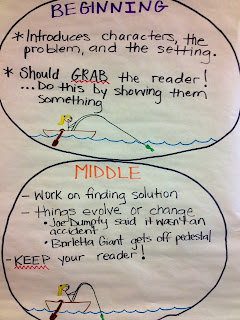Today your child graduated from multiplication to division and I couldn't be more proud! We learned that as with multiplication (which is used to quickly add repeated numbers), division is used to quickly subtract repeated numbers. Throughout this EnVision Topic we will learn two interpretations of division, how to model the difference between the two different interpretations, and how to apply whichever model works best for your kiddo to real life situations.
Case in point: I can't think of a more fun and enjoyable way for your third grader to celebrate graduating than with some March Madness Math! We are capitalizing on what is being referred to in our classroom as "the Madness" by combining many different aspects of learning :)
I told the kids that in the NCAA tournament, 16 teams start out in each of 4 regions. Since bracketology involves the same number of teams playing per region, we used that knowledge combined with what we know about multiplication to help figure out how many total teams are involved in the Madness (16 x 4 = 64). We used the 4's trick to help solve, too! (16x2=32, 32+32=64).

We also know certain things happen within each region to help narrow down the 16 teams. For example in each game, there can only be 2 teams that play and 1 winner of that game. We used what we just learned about division to help understand the systematic process taking place within each region to get us down to semi-finals, and ultimately "THE BIG DANCE!" (16/2=8, 8/2=4, 4/2=2, and 2/2=1 team left per region).
Combine all of that with the energy and excitement that comes naturally when talking about rivalries, underdogs, big dunks, and teamwork on the basketball court- and it isn't hard to understand how Madness Math has quickly become the highlight of our days here at Rush!
The atmosphere in our classroom when we incorporate lively discussions with relevant learning targets is truly special. Everyone is engaged, focused, respecting each other's opinions, and having fun! For instance, after we wrapped up the Madness today and were filling out our Daily Planners, one student came up to me and said, "Miss Dupart I think our Florida Gulf Coast team is going to win on Friday because in our planners it says that Friday is 'Good Friday'"...I couldn't help myself but to laugh out loud; you know me :) What a wonderful thought!
The boys and girls also have the opportunity to earn a vote at the end of the day for who they think is going to win what match-ups are left... today everyone voted for the Sweet 16 winners! Any opportunity to build on community and classroom environment... :)
 The students love standing around watching and conversing about the
crayfish.. they’re like little living magnets!
They’re terrific animals for us to study with fascinating
appearances. They’re quite bizarre with
an array of legs, appendages, and movements.
The students love standing around watching and conversing about the
crayfish.. they’re like little living magnets!
They’re terrific animals for us to study with fascinating
appearances. They’re quite bizarre with
an array of legs, appendages, and movements.




.JPG)


.jpg)


